A Risk-Based Approach to Assess the Operational Resilience of Transmission Grids
Abstract
1. Introduction
Operational Grid Resilience: Background and Definitions
2. Materials and Methods
2.1. Risk-Based Methodology
- Step 1: Threat/Event characterization,
- Step 2: Vulnerability of system’s components,
- Step 3: System response, and
- Step 4: System restoration.
2.2. Transmission Availability Data System (TADS)
2.2.1. Overview
2.2.2. Analysis Dataset and Definitions
3. Results
3.1. Analysis of Clusters
3.1.1. Clusters by Year and Size Distribution
3.1.2. Initiating Causes of Outages
3.1.3. Cluster Duration
3.1.4. Analysis of Largest Clusters
3.2. Cluster Risk to Transmission Owner (TO)
3.2.1. Distribution of Clusters by TO
3.2.2. Company Risk Assessment
4. Discussion
5. Conclusions
Author Contributions
Funding
Acknowledgments
Conflicts of Interest
References
- National Infrastructure Advisory Council. A Framework for Establishing Critical Infrastructure Resilience Goals; National Infrastructure Advisory Council: Washington D.C., USA, 2010.
- North American Electric Reliability Corporation. Severe Impact Resilience: Considerations and Recommendations; North American Electric Reliability Corporation: Atlanta, GA, USA, 2012. [Google Scholar]
- National Academy of Sciences. Terrorism and the Electric Power Delivery System. 2012. Available online: https://www.nap.edu/login.php?record_id=12050&page=https%3A%2F%2Fwww.nap.edu%2Fdownload%2F12050 (accessed on 2 May 2020).
- Executive Office of the President of the United States. Economic Benefits of Increasing Electric Grid Resilience to Weather Outages. 2013. Available online: http://energy.gov/sites/prod/files/2013/08/f2/Grid%20Resiliency%20Report_FINAL.pdf (accessed on 2 May 2020).
- National Research Council. The Resilience of the Electric Power Delivery System in Response to Terrorism and Natural Disasters: Summary of a Workshop; The National Academies Press: Washington, DC, USA, 2013.
- National Academies of Sciences. Engineering, and Medicine. Enhancing the Resilience of the Nation’s Electricity System; The National Academies Press: Washington, DC, USA, 2017. [Google Scholar] [CrossRef]
- Resilient Electricity Networks for Great Britain, (RESNET). Available online: https://www.tyndall.ac.uk/projects/resnet-resilient-electricity-networks-great-britain (accessed on 2 May 2020).
- North American Electric Reliability Corporation. Reliability Standards for the Bulk Electric Systems of North America. 2020. Available online: https://www.nerc.com/pa/Stand/Pages/AllReliabilityStandards.aspx (accessed on 2 May 2020).
- National Oceanic and Atmospheric Administration. National Centers for Environmental Information. U.S. Billion-Dollar Weather and Climate Disasters: Overview. 2019. Available online: https://www.ncdc.noaa.gov/billions/ (accessed on 2 May 2020).
- Venu, V.V.; Verma, A.K. A Novel Adequacy Resiliency Paradigm for Power System Reliability Measures. In Proceedings of the IEEE Power and Energy Society General Meeting, Minneapolis, MN, USA, 25–29 July 2010. [Google Scholar]
- Ly, T.C.; Moura, J.N.; Velummylum, G. Assessing the Bulk System’s Resource Resilience to Future Extreme Winter Weather Events. In Proceedings of the IEEE PES General Meeting, Denver, CO, USA, 26–30 July 2015. [Google Scholar]
- Van Harte, M.; Koch, R.; Mike, N.; Havford, G.; Bala, M. Integrated risk management and system adequacy assessment: Implementation of the ISO 31000:2009 standard. In Proceedings of the South African power system CIGRE Conference, Recife, Brazil, 3–6 April 2011. [Google Scholar]
- Ciapesoni, E.; Cirio, D.; Pitto, A.; Masucco, S.; Sforna, M.P. Security-Constrained Redispatching to enhance power system resilience in case of wet snow events. In Proceedings of the Power System Computation Conference (PSCC), Genoa, Italy, 11–15 June 2018. [Google Scholar]
- Eskandarpour, R.; Edwards, G.; Khodaei, A. Resilience-Constrained Unit Commitment Considering the Impact of Microgrid. In Proceedings of the North American Power Symposium, Denver, CO, USA, 18–20 September 2016. [Google Scholar]
- Li, G.; Zhang, P.; Luh, P.B.; Li, W.; Bie, Z.; Serna, C.; Zhao, Z. Risk Analysis for Distribution Systems in the Northeast U.S. Under Wind Storms. IEEE Trans. Power Syst. 2013, 29, 889–898. [Google Scholar] [CrossRef]
- Yuan, W.; Wang, J.; Qiu, F.; Chen, C.; Kang, C.; Zeng, B. Robust optimization-based resilient distribution network planning against natural disasters. IEEE Trans. Smart Grid 2016, 7, 2817–2826. [Google Scholar] [CrossRef]
- Chen, C.; Wang, J.; Ton, D. Modernizing Distribution System Restoration to Achieve Grid Resiliency Against Extreme Weather Events: An Integrated Solution. Proc. IEEE 2017, 105, 1267–1288. [Google Scholar] [CrossRef]
- Liu, Y.; Fan, R.; Terzija, V. Power system restoration: A literature review from 2006 to 2016. J. Mod. Power Syst. Clean Energy 2016, 4, 332–341. [Google Scholar] [CrossRef]
- Hongda, R.; Schulz, N. A Clustering-based Microgrid Planning for Resilient Restoration in Power Distribution System. IEEE T & D. 2020. Available online: https://www.ieeet-d.org/IEEE20/Public/SessionDetails.aspx?FromPage=Sessions.aspx&SessionID=1191&SessionDateID=17 (accessed on 10 July 2020).
- Li, Z.; Shahidehpour, M.; Aminifar, F.; AlAbdulwahab, A.; Al-Turki, Y. Networked Microgrids for Enhancing the Power System Resilience. Proc. IEEE 2017, 105, 1289–1310. [Google Scholar] [CrossRef]
- Lassetter, C.; Cotilla-Sanchez, E.; Kim, J. A Learning Scheme for Microgrid Reconnection. IEEE Trans. Power Syst. 2018, 33, 691–700. [Google Scholar] [CrossRef]
- Schneider, K.P.; Tuffner, F.K.; Elizondo, M.A.; Liu, C.C.; Xu, Y.; Ton, D. Evaluating the feasibility to use microgrids as a resiliency resource. IEEE Trans. Smart Grid 2017, 8, 687–696. [Google Scholar]
- Fan, N.; Izraelevitz, D.; Pan, F.; Pardalos, P.M.; Wang, J. A mixed integer programming approach for optimal power grid intentional islanding. Energy Syst. 2012, 3, 77–93. [Google Scholar] [CrossRef]
- Sun, W.; Liu, C.-C.; Zhang, L. Optimal generator start-up strategy for bulk power system restoration. IEEE Trans. Power Syst. 2011, 26, 1357–1366. [Google Scholar] [CrossRef]
- Qiu, F.; Li, P. An integrated approach for power system restoration planning. Proc. IEEE 2017, 105, 1234–1252. [Google Scholar] [CrossRef]
- Ton, D.T.; Wang, P.W.-T. A more Resilient Grid. IEEE Power Energy Mag. 2015, 13, 26–34. [Google Scholar] [CrossRef]
- Arab, A.; Khodaei, A.; Khator, S.K.; Ding, K.; Emesih, V.A.; Han, Z. Stochastic Pre-Hurricane Restoration Planning for Electric Power Systems Infrastructure. IEEE Trans. Smart Grid 2015, 6, 1046–1054. [Google Scholar] [CrossRef]
- Romero, N.R.; Nozick, L.K.; Dobson, I.D.; Xu, N.; Jones, D. Transmission and Generation Expansion to Mitigate Seismic Risk. IEEE Trans. Power Syst. 2013, 28, 3692–3701. [Google Scholar] [CrossRef]
- Romero, N.; Xu, N.; Nozick, L.K.; Dobson, I.; Jones, D. Investment Planning for Electric Power Systems Under Terrorist Threat. IEEE Trans. Power Syst. 2011, 27, 108–116. [Google Scholar] [CrossRef]
- Lagos, T.; Moreno, R.; Espinosa, A.N.; Panteli, M.; Sacaan, R.; Ordonez, F.; Rudnick, H.; Mancarella, P.; Navarro, A. Identifying Optimal Portfolios of Resilient Network Investments Against Natural Hazards, With Applications to Earthquakes. IEEE Trans. Power Syst. 2020, 35, 1411–1421. [Google Scholar] [CrossRef]
- Nagarajan, H.; Yamangil, E.; Bent, R.; Van Hententyck, P.; Backhaus, S. Optimal resilient transmission grid design. In Proceedings of the Power System Computation Conference (PSCC), Genoa, Italy, 1–8 June 2016. [Google Scholar]
- U.S. Department of Energy. Hardening and Resiliency: U.S. Energy Industry Response to Recent Hurricane Seasons. 2010. Available online: http://www.oe.netl.doe.gov/docs/HR-Re-port-final-081710.pdf (accessed on 2 May 2020).
- Panteli, M.; Trakas, D.N.; Mancarella, P.; Hatziargyriou, N.D. Boosting the Power Grid Resilience to Extreme Weather Events Using Defensive Islanding. IEEE Trans. Smart Grid 2016, 7, 2913–2922. [Google Scholar] [CrossRef]
- Guo, J.; Wang, Y.; Guo, C.; Dong, S.; Wen, B. Cyber-Physical Power System (CPPS) Reliability Assessment Considering Cyber Attacks against Monitoring Functions. In Proceedings of the IEEE Power and Energy Society General Meeting, Boston, MA, USA, 17–21 July 2016. [Google Scholar]
- Al-Ammar, E.; Fisher, J. Resiliency Assessment of the Power System Network to Cyber and Physical Attacks. In Proceedings of the IEEE Power and Energy Society General Meeting, Montreal, QC, Canada, 18–22 June 2006. [Google Scholar]
- Gardner, R.M.; Grid Consortium. A Survey of ICT Vulnerabilities of Power Systems and Relevant Defense Methodologies. In Proceedings of the IEEE PES General Meeting, Tampa, FL, USA, 24–28 June 2007. [Google Scholar]
- Huang, G.; Wang, J.; Chen, C.; Qi, J.; Guo, C. Integration of Preventive and Emergency Responses for Power Grid Resilience Enhancement. IEEE Trans. Power Syst. 2017, 32, 1. [Google Scholar] [CrossRef]
- Ciapesoni, E.; Cirio, D.; Pitto, A.; Sforma, M. An Integrated Framework for Power and ICT System Risk-Based Security Assessment. Int. J. Eng. Res. Appl. 2014, 4, 42–51. [Google Scholar]
- Yan, J.; Tang, Y.; Tang, B.; He, H.; Sun, Y. Power Grid Resilience Against False ta Injection Attacks. In Proceedings of the IEEE Power and Energy Society General Meeting, Boston, MA, USA, 17–21 July 2016. [Google Scholar]
- Van Harte, M.; Panteli, M.; Koch, R.; Mahomed, S.; Jordaan, A. Resiliency of critical infrastructure: Power system resilience capabilities and assessment framework. In Proceedings of the DMISA Conference, Eastern Cape Province, South Africa, 27–28 September 2017. [Google Scholar]
- Panteli, M. Assessment of the Resilience of Transmission Networks to Extreme Wind Events. In Proceedings of the 52nd Hawaii International Conference on System Sciences, Maui, HI, USA, 8–11 January 2019. [Google Scholar]
- Zhang, H.; Yuan, H.; Li, G.; Lin, Y. Quantitative Resilience Assessment under a Tri-Stage Framework for Power Systems. Energies 2018, 11, 1427. [Google Scholar] [CrossRef]
- Ciapesoni, E.; Cirio, D.; Pitto, A.; Masucco, S.; Sforna, M.; Marcacci, P. Model based resilience assessment and threats mitigation: A sensitivity based approach. In Proceedings of the 2018 AEIT International Annual Conference, Bari, Italy, 3–5 October 2018. [Google Scholar]
- Ciapessoni, E.; Cirio, D.; Kjølle, G.; Massucco, S.; Pitto, A.; Sforna, M. Probabilistic Risk-Based Security Assessment of Power Systems Considering Incumbent Threats and Uncertainties. IEEE Trans. Smart Grid 2016, 7, 2890–2903. [Google Scholar] [CrossRef]
- Chi, Y.; Xu, Y.; Hu, C.; Feng, S. A State-of-the Art Literature Survey of Power Distribution System Resilience Assessment. In Proceedings of the IEEE Power and Energy Society General Meeting, Portland, OR, USA, 5–9 August 2018. [Google Scholar]
- Wang, Y.; Chen, C.; Wang, J.; Baldick, R. Research on Resilience of Power Systems Under Natural DisastersA Review. IEEE Trans. Power Syst. 2015, 31, 1–10. [Google Scholar] [CrossRef]
- Arab, A.; Khodaei, A.; Han, Z.; Khator, S.K. Proactive Recovery of Electric Power Assets for Resiliency Enhancement. IEEE Access 2015, 3, 99–109. [Google Scholar] [CrossRef]
- Van Harte, M.A.; Koch, R.; Nambiar, A.; Joseph, S.; Tshwagong, I.; Naidoo, L.; Heideman, U. Power system resilience—Enablers supporting an effective Blackout response. In Proceedings of the CIGRE 8th Southern Africa Regional Conference, Somerset West Cape, South Africa, 14–17 November 2017. [Google Scholar]
- Perrings, C.; Larson, E.K.; Maliszewski, P.J. Valuing the resilience of the electrical power infrastructure. In Proceedings of the IEEE Power and Energy Society General Meeting, Detroit, MI, USA, 24–28 July 2011. [Google Scholar]
- Ju, C.; Yao, S.; Wang, P. Resilient Post-Disaster System Reconfiguration for Multiple Energy Service Restoration. In Proceedings of the IEEE Conference on Energy Internet and Energy System Integration (EI2), Beijing, China, 26–28 November 2017. [Google Scholar]
- North American Electric Reliability Corporation. Transmission Availability Data System (TADS) Definitions. 2016. Available online: https://www.nerc.com/pa/RAPA/tads/Pages/default.aspx (accessed on 2 May 2020).
- Papic, M.; Clemons, M.; Ekisheva, S.; Langthorn, J.; Ly, T.; Pakeltis, M.; Quest, R.; Schaller, J.; Till, D.; Weisman, K. Transmission Availability Data System (TADS) Reporting and Data Analysis. In Proceedings of the 12th International Conference Probabilistic Methods Applied to Power Systems, PMAPS, Beijing, China, 16–20 October 2016. [Google Scholar]
- Bian, J.; Ekisheva, S.; Slone, A. Top Risks to Transmission Outages. In Proceedings of the IEEE PES General Meeting, Washington, DC, USA, 27–31 July 2014. [Google Scholar]
- Ekisheva, S.; Gugel, H. North American AC Circuit Outage Rates and Durations in Assessment of Transmission System Reliability and Availability. In Proceedings of the IEEE PES General Meeting, Denver, CO, USA, 26–30 July 2015. [Google Scholar]
- Ekisheva, S.; Gugel, H. North American Transformer Outage Rates and Durations in Assessment of Transmission System Reliability and Availability. In Proceedings of the IEEE PES General Meeting, Denver, CO, USA, 26–30 July 2015. [Google Scholar]
- Ekisheva, S.; Lauby, M.G.; Gugel, H. North American Transformer Outages Initiated by Transmission Equipment Failures and Human Error. In Proceedings of the IEEE PES General Meeting, Boston, MA, USA, 17–21 July 2016. [Google Scholar]
- Schaller, J.; Ekisheva, S. Leading Causes of Outages for Transmission Elements of the North American Bulk Power System. In Proceedings of the PES General Meeting, Boston, MA, USA, 17–21 July 2016. [Google Scholar]
- Ekisheva, S.; Papic, M.; Clemons, M.S.; Quest, R.; Pakeltis, M.J.; Weisman, K. Outage Statistics, Reliability and Availability of DC Circuits in North American Bulk Power System. In Proceedings of the IEEE PES General Meeting, Chicago, IL, USA, 16–20 July 2017. [Google Scholar]
- Billinton, R. Basic models and methodologies for common mode and dependent transmission outage events. In Proceedings of the IEEE PES General Meeting, San Diego, CA, USA, 22–26 July 2012. [Google Scholar]
- Papic, M.; Awodele, K.; Billinton, R.; Dent, C.; Eager, D.; Hamoud, G.; Jirutitijaroen, C.P.; Kumbale, M.; Mitra, J.; Samaan, N.A.; et al. Overview of common mode outages in power systems. In Proceedings of the IEEE PES General Meeting, San Diego, CA, USA, 22–26 July 2012. [Google Scholar]
- Papic, M.; Agarwal, S.; Bian, J.; Billinton, R.; Dent, C.; Dobson, I.; Jirutitijaroen, P.; Li, W.; Menten, T.; Mitra, J.; et al. Effects of Dependent and Common Mode Outages on the Reliability of Bulk Electric System—Part I: Basic Concepts. In Proceedings of the IEEE PES General Meeting, Washington, DC, USA, 27–31 July 2014. [Google Scholar]
- Papic, M.; Agarwal, S.; Bian, J.; Billinton, R.; Dent, C.; Dobson, I.; Jirutitijaroen, P.; Li, W.; Menten, T.; Mitra, J.; et al. Effects of Dependent and Common Mode Outages on the Reliability of Bulk Electric System—Part II: Outage Data Analysis. In Proceedings of the IEEE PES General Meeting, Washington, DC, USA, 27–31 July 2014. [Google Scholar]
- Papic, M.; Agarwal, S.; Allan, R.N.; Billinton, R.; Dent, C.; Ekisheva, S.; Gent, D.; Jiang, K.; Li, W.; Mitra, J.; et al. Research on Common-Mode and Dependent (CMD) Outage Events in Power Systems—A Review. IEEE Trans. Power Syst. 2016, 32, 1. [Google Scholar] [CrossRef]
- IEEE PES Task Force on Cascading Failure. Initial review of methods for cascading failure analysis in electric power transmission systems. In Proceedings of the IEEE PES General Meeting, Pittsburgh, PA, USA, 20–24 July 2008. [Google Scholar]
- Vaiman; Bell, K.; Chen; Chowdhury; Dobson, I.; Hines; Papic; Miller; Zhang. Risk Assessment of Cascading Outages: Methodologies and Challenges. IEEE Trans. Power Syst. 2011, 27, 631–641. [Google Scholar] [CrossRef]
- Bialek, J.; Ciapessoni, E.; Cirio, D.; Cotilla-Sanchez, E.; Dent, C.; Dobson, I.; Henneaux, P.; Hines, P.; Jardim, J.; Miller, S.; et al. Benchmarking and Validation of Cascading Failure Analysis Tools. IEEE Trans. Power Syst. 2016, 31, 4887–4900. [Google Scholar] [CrossRef]
- Henneaux, P.; Ciapessoni, E.; Cirio, D.; Cotilla-Sanchez, E.; Diao, R.; Dobson, I.; Gaikwad, A.; Miller, S.; Papic, M.; Pitto, A.; et al. Benchmarking Quasi-Steady State Cascading Outage Analysis Methodologies. In Proceedings of the International Conference on Probabilistic Methods Applied to Power Systems (PMAPS), Boise, ID, USA, 24–28 June 2018. [Google Scholar]
- Carreras, B.A.; Newman, D.E.; Dobson, I.; Degala, N.S. Validating OPA with WECC data. In Proceedings of the Hawaii International Conference on System Sciences, Maui, HI, USA, 7–10 January 2013. [Google Scholar]
- Dobson, I. Estimating the Propagation and Extent of Cascading Line Outages From Utility Data With a Branching Process. IEEE Trans. Power Syst. 2012, 27, 2146–2155. [Google Scholar] [CrossRef]
- Papic, M.; Dobson, I. Comparing a Transmission Planning Study of Cascading with Historical Line Outage Data. In Proceedings of the PMAPS International Conference, Beijing, China, 16–20 October 2016. [Google Scholar]
- Dobson, I.; Carrington, N.; Zhou, K.; Wang, Z.; Carreras, B.A.; Reynolds-Barredo, J.M. Exploring Cascading Outages and Weather via Processing Historic Data. In Proceedings of the 51st Hawaii International Conference on System Sciences, Hilton Waikoloa Village, HI, USA, 3–6 January 2018. [Google Scholar]
- Eskandarpour, R.; Khodaei, A.; Arab, A. Improving Power Grid Resilience through Predictive Outage Estimation. In Proceedings of the North American Power Symposium, Morgantown, WV, USA, 17–19 September 2017. [Google Scholar]
- Kelly-Gorham, M.R.; Hines, P.; Dobson, I. Using historical utility outage data to compute overall transmission grid resilience. In Proceedings of the IEEE PES General Meeting, Atlanta, GA, USA, 6–8 August 2019. [Google Scholar]
- Thompson, C.C.; Stringer, A.D.; Barriga, C.I. An Evaluation of Transformer Historical Failure Data for Facility Resiliency and Reliability. In Proceedings of the IEEE Power and Energy Society General Meeting, Atlanta, GA, USA, 4–8 August 2019. [Google Scholar]
- Campbell, R.J. Weather-Related Outages and Electric System Resiliency; Congressional Research Service: Washington D.C., USA, 2012.
- Eskandarpour, R.; Khodaei, A. Machine Learning Based Power Grid Outage Prediction in Response to Extreme Events. IEEE Trans. Power Syst. 2017, 32, 3315–3316. [Google Scholar] [CrossRef]
- Dagle, J. Resilient Networks Minitrack. In Proceedings of the 52nd Hawaii International Conference on System Sciences, Grand Wailea, Maui, HI, USA, 8–11 January 2019. [Google Scholar]
- Duchesne, L.; Karangelos, E.; Wehenkel, L. Using Machine Learning to Enable Probabilistic Reliability Assessment in Operation Planning. In Proceedings of the Power System Computation Conference (PSCC), Dublin, Ireland, 11–15 June 2018. [Google Scholar]
- North American Electric Reliability. Corporation State of Reliability. 2019. Available online: www.nerc.com/pa/RAPA/PA/Performance%20Analysis%20DL/NERC_SOR_2019.pdf (accessed on 2 May 2020).
- Papic, M.; Ekisheva, S.; Robinson, J.; Cummings, R. Multiple Outage Challenges to Transmission Grid Resilience. In Proceedings of the IEEE PES General Meeting, Atlanta, GA, USA, 4–8 August 2019. [Google Scholar]
- Gholami, A.; Shiekari, T.; Amirioun, M.H.; Aminifar, F.; Amini, M.H.; Sargolzaei, A. Toward a Consensus on the Definition and Taxomony of Power System Resilience. IEEE Access 2018, 6, 32035–32053. [Google Scholar] [CrossRef]
- Venkata, S.S.; Hatziargyriou, N. Grid Resilience. IEEE Power Energy Mag. 2015, 13, 16–23. [Google Scholar] [CrossRef]
- International Council on Large Electric Systems. C4.47 PSR Working Group; Power System Resilience Definition; International Council on Large Electric Systems: Paris, France, 2018. [Google Scholar]
- Lowrance, W.W. Of acceptable risk. Science and the determination of safety. J. Chem. Educ. 1977, 54, A345. [Google Scholar] [CrossRef]
- Piacenza, J.R.; Faller, K.J.; Bozorgirad, M.A.; Cotilla-Sanchez, E.; Hoyle, C.; Tumer, I. Understanding the Impact of Decision Making on Robustness During Complex System Design: More Resilient Power Systems. ASCE-ASME J. Risk Uncertain. Eng. Syst. Part B Mech. Eng. 2019, 6. [Google Scholar] [CrossRef]
- Espinoza, S.; Poulos, A.; Rudnick, H.; De La Llera, J.C.; Panteli, M.; Mancarella, P. Risk and Resilience Assessment With Component Criticality Ranking of Electric Power Systems Subject to Earthquakes. IEEE Syst. J. 2020, 14, 2837–2848. [Google Scholar] [CrossRef]
- Natural Environment Research Council. Bulk Electric System (BES) Definition, Notification, and Exception Process. Available online: http://www.nerc.com/pa/RAPA/Pages/BES.aspx (accessed on 2 May 2020).
- Karki, R.; Dhungana, D.; Billinton, R. An Appropriate Wind Model for Wind Integrated Power Systems Reliability Evaluation Considering Wind Speed Correlations. Appl. Sci. 2013, 3, 107–121. [Google Scholar] [CrossRef]
- Johnson, B.; Cotilla-Sanchez, E. Estimating the impact of ocean wave energy on power system reliability with a well-being approach. IET Renew. Power Gener. 2020, 14, 608–615. [Google Scholar] [CrossRef]
- Linkov, I.; Bridges, T.; Creutzig, F.; Decker, J.; Fox-Lent, C.; Kröger, W.; Lambert, J.H.; Levermann, A.; Montreuil, B.; Nathwani, J.; et al. Changing the resilience paradigm. Nat. Clim. Chang. 2014, 4, 407–409. [Google Scholar] [CrossRef]
- Papic, M.; Ciniglio, O. Prevention of NERC C3 Category Outages in Idaho Power’s Network: Risk Based Methodology and Practical Application. In Proceedings of the IEEE PES General Meeting, Vancouver, BC, Canada, 21–25 July 2013; pp. 1–6. [Google Scholar]
- Federal Energy Regulatory Commission. Comments of the North American Electric Reliability Corporation; Federal Energy Regulatory Commission: Washington D.C., USA, 2018.
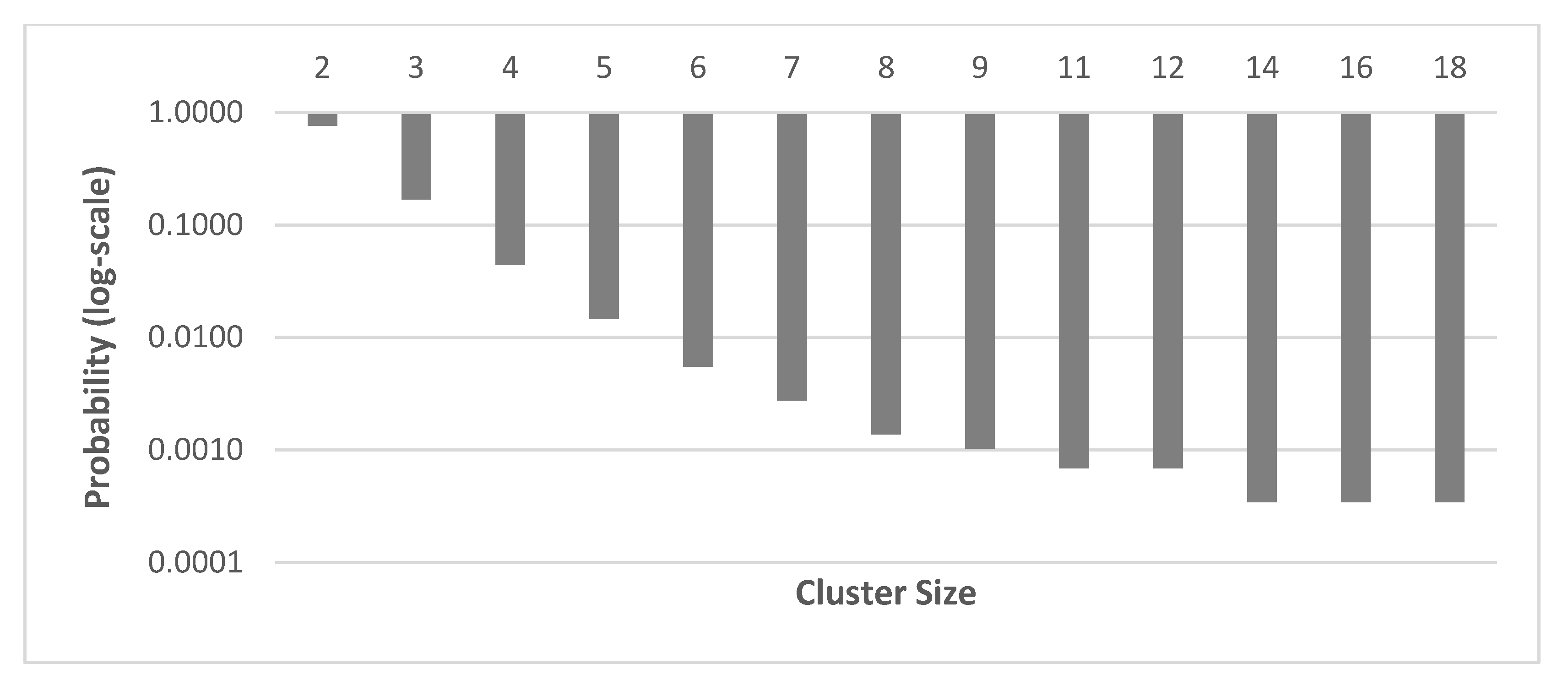
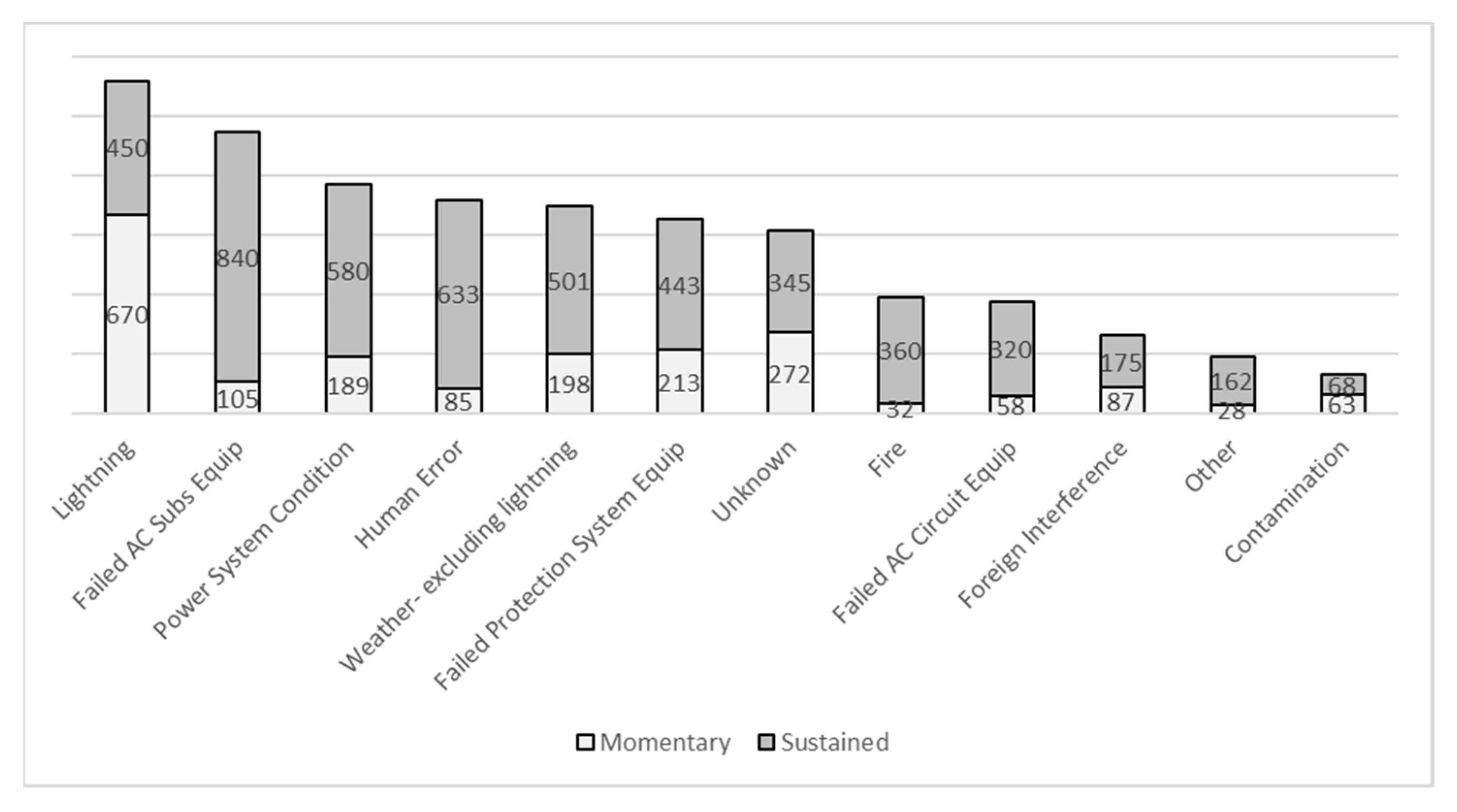
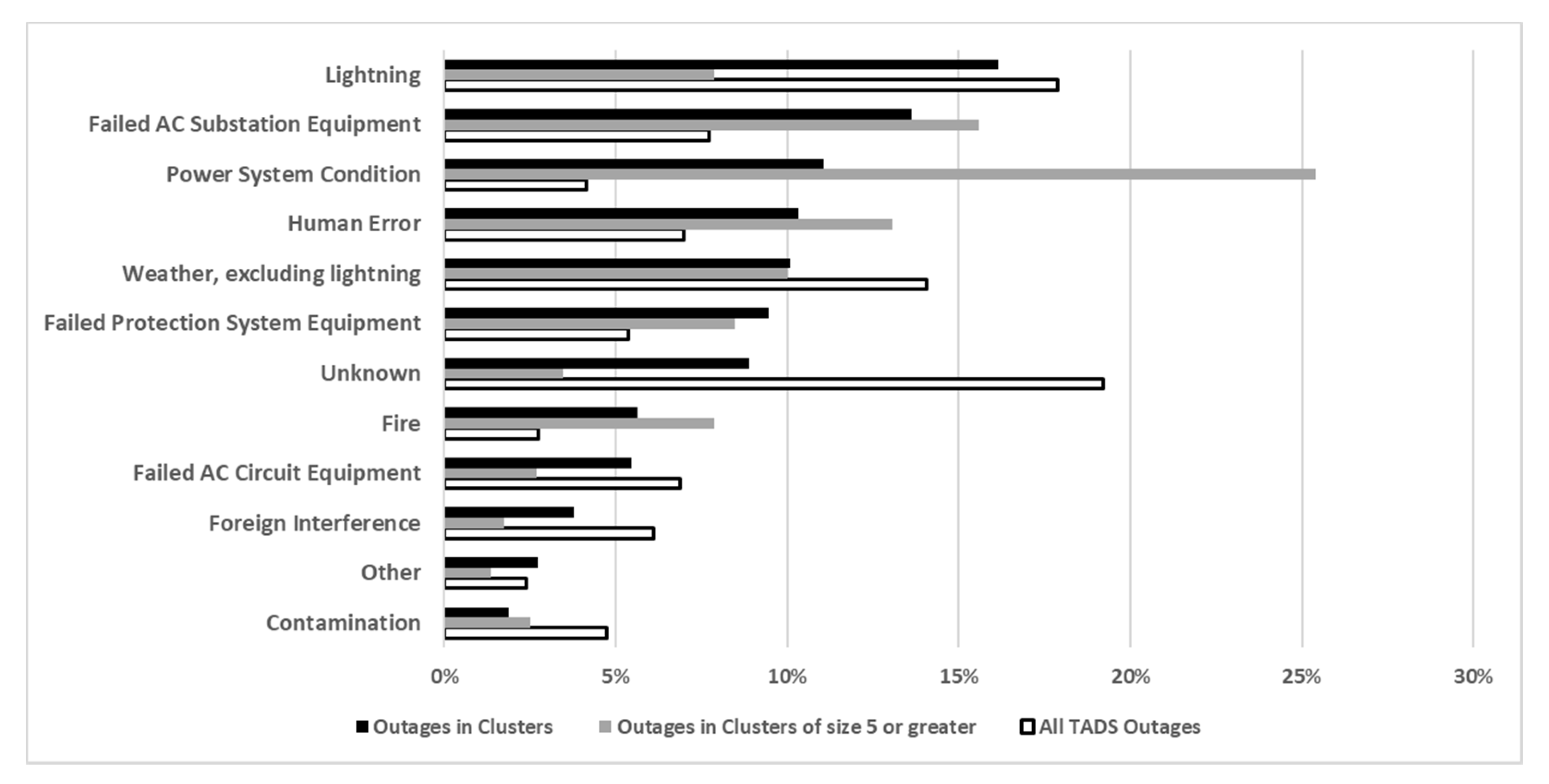
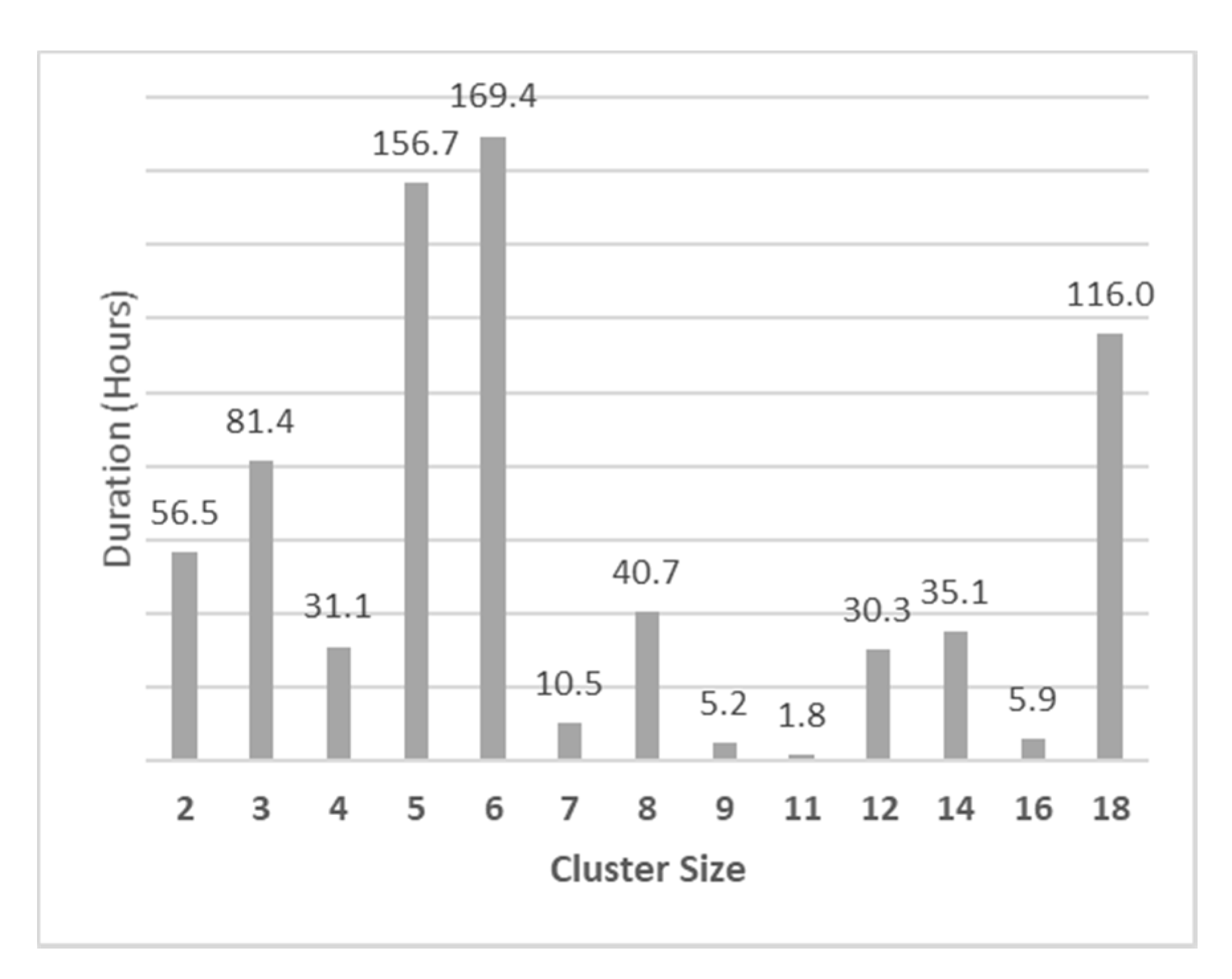
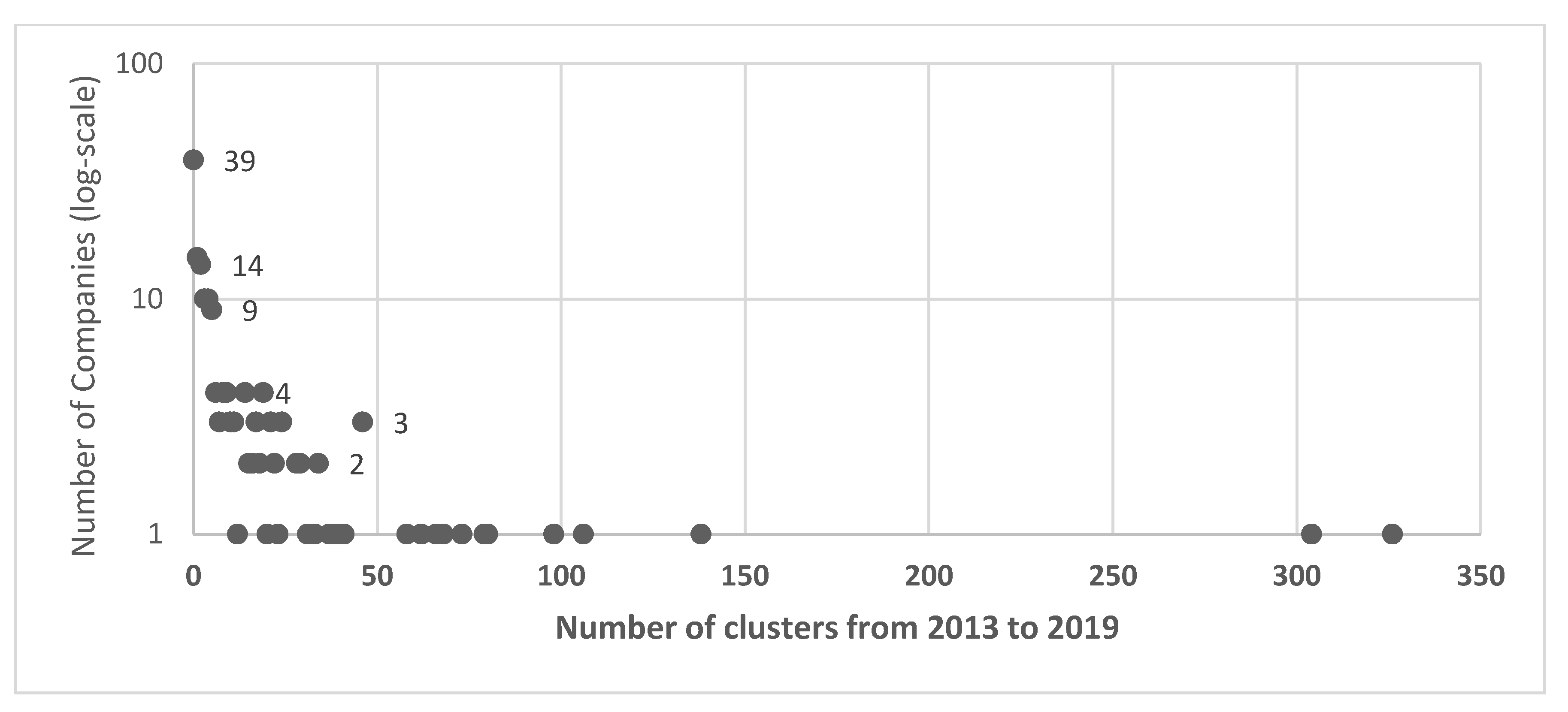
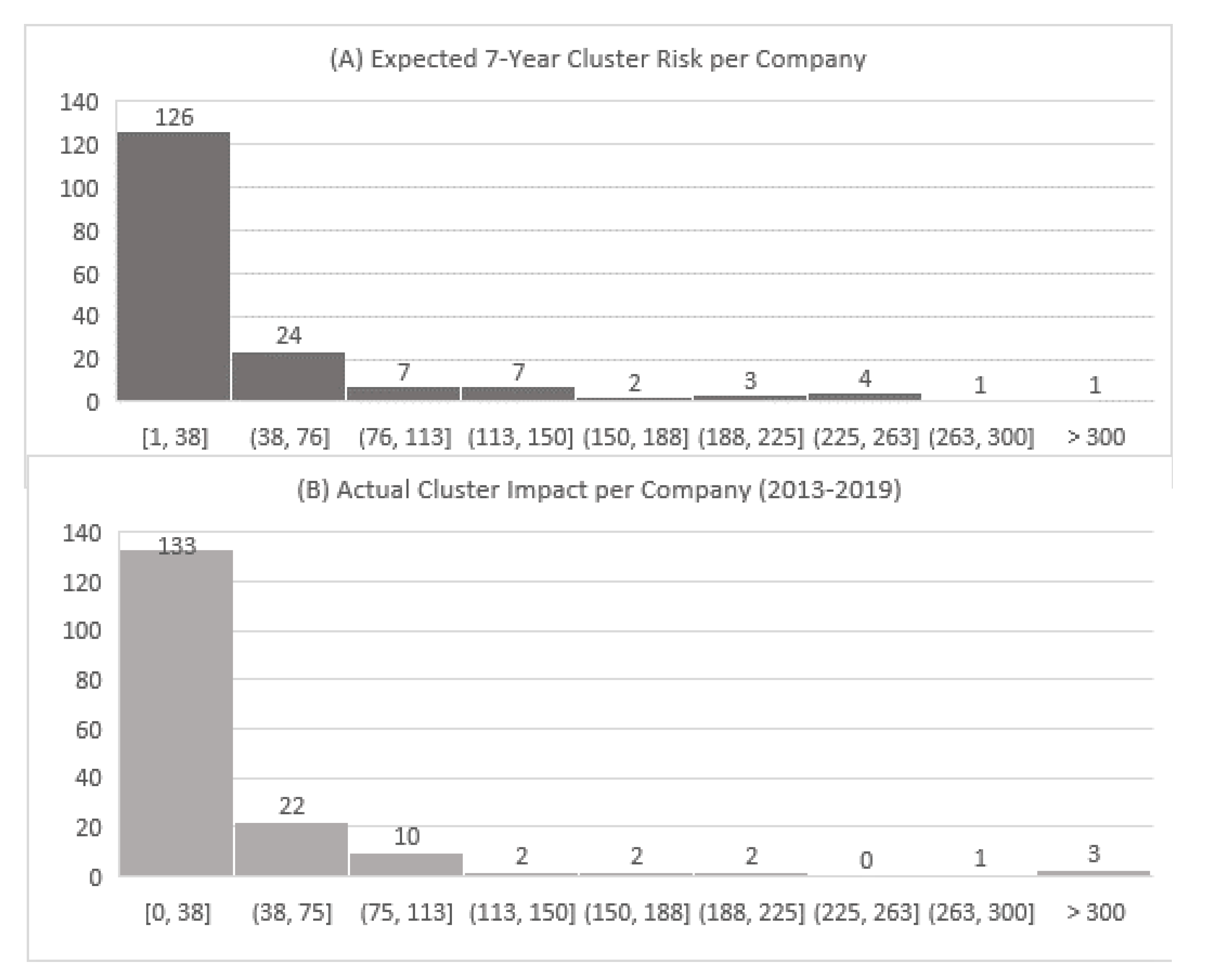
| Voltage Class | AC Circuit | AC/DC BTB Converter | DC Circuit | Transformer |
|---|---|---|---|---|
| 200–299 kV | 3034 | 12 | 17 | 604 |
| 300–399 kV | 1621 | 26 | 403 | |
| 400–499 kV * | 37 | |||
| 400–599 kV | 594 | 389 | ||
| 500–599 kV * | 39 | |||
| 600–799 kV | 123 | 43 | ||
| Grand Total | 5372 | 38 | 93 | 1439 |
| Cluster Size | 2013 | 2014 | 2015 | 2016 | 2017 | 2018 | 2019 | 2013–2019 |
|---|---|---|---|---|---|---|---|---|
| 2 | 290 | 249 | 340 | 320 | 336 | 334 | 349 | 2218 |
| 3 | 86 | 54 | 67 | 92 | 74 | 53 | 64 | 490 |
| 4 | 23 | 14 | 20 | 14 | 21 | 25 | 12 | 129 |
| 5 | 9 | 7 | 3 | 6 | 2 | 9 | 7 | 43 |
| 6 | 0 | 3 | 5 | 2 | 1 | 1 | 4 | 16 |
| 7 | 1 | 1 | 0 | 0 | 2 | 2 | 2 | 8 |
| 8 | 1 | 0 | 1 | 0 | 0 | 1 | 1 | 4 |
| 9 | 1 | 0 | 0 | 1 | 1 | 0 | 0 | 3 |
| 11 | 0 | 0 | 0 | 0 | 1 | 1 | 0 | 2 |
| 12 | 1 | 0 | 0 | 0 | 0 | 1 | 0 | 2 |
| 14 | 0 | 0 | 0 | 0 | 0 | 0 | 1 | 1 |
| 16 | 0 | 0 | 0 | 0 | 0 | 0 | 1 | 1 |
| 18 | 1 | 0 | 0 | 0 | 0 | 0 | 0 | 1 |
| All sizes | 413 | 328 | 436 | 435 | 438 | 427 | 441 | 2918 |
| Cluster Size | Year | Duration (Hours) | TADS Elements | Initiating Causes of Outages |
|---|---|---|---|---|
| 9 | 2013 | 2.3 | 9 ac | Lightning |
| 9 | 2017 | 11.6 | 8 ac, 1 trans | Power system condition, Human error, Unknown |
| 9 | 2016 | 1.6 | 9 ac | Failed AC substation equipment |
| 11 | 2017 | 2.0 | 4 ac, 7 trans | Human error, Power system condition |
| 11 | 2018 | 1.6 | 4 ac, 7 trans | Lightning, Power system condition |
| 12 | 2018 | 11.9 | 12 ac | Human error, Fire, Power system condition |
| 12 | 2013 | 48.7 | 12 ac | Contamination |
| 14 | 2019 | 35.1 | 13 ac, 1 trans | Fire, Power system condition |
| 16 | 2019 | 5.9 | 13 ac, 3 trans | Fire, Power system condition (wildfires in California) |
| 18 | 2013 | 116.0 | 18 ac | Weather-initiated (extreme rainfall) |
| Expected Number of Clusters | Cluster Size | |||||||||||||
|---|---|---|---|---|---|---|---|---|---|---|---|---|---|---|
| 2 | 3 | 4 | 5 | 6 | 7 | 8 | 9 | 11 | 12 | 14 | 16 | 18 | All Sizes | |
| 7 years | 15.433 | 3.409 | 0.898 | 0.299 | 0.111 | 0.056 | 0.028 | 0.021 | 0.014 | 0.014 | 0.007 | 0.007 | 0.007 | 20.304 |
| 1 year | 2.205 | 0.487 | 0.128 | 0.043 | 0.016 | 0.008 | 0.004 | 0.003 | 0.002 | 0.002 | 0.001 | 0.001 | 0.001 | 2.901 |
© 2020 by the authors. Licensee MDPI, Basel, Switzerland. This article is an open access article distributed under the terms and conditions of the Creative Commons Attribution (CC BY) license (http://creativecommons.org/licenses/by/4.0/).
Share and Cite
Papic, M.; Ekisheva, S.; Cotilla-Sanchez, E. A Risk-Based Approach to Assess the Operational Resilience of Transmission Grids. Appl. Sci. 2020, 10, 4761. https://doi.org/10.3390/app10144761
Papic M, Ekisheva S, Cotilla-Sanchez E. A Risk-Based Approach to Assess the Operational Resilience of Transmission Grids. Applied Sciences. 2020; 10(14):4761. https://doi.org/10.3390/app10144761
Chicago/Turabian StylePapic, Milorad, Svetlana Ekisheva, and Eduardo Cotilla-Sanchez. 2020. "A Risk-Based Approach to Assess the Operational Resilience of Transmission Grids" Applied Sciences 10, no. 14: 4761. https://doi.org/10.3390/app10144761
APA StylePapic, M., Ekisheva, S., & Cotilla-Sanchez, E. (2020). A Risk-Based Approach to Assess the Operational Resilience of Transmission Grids. Applied Sciences, 10(14), 4761. https://doi.org/10.3390/app10144761





